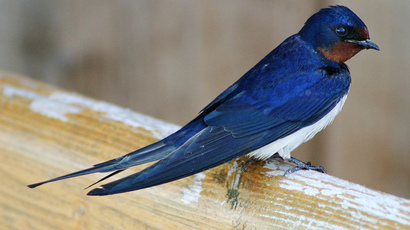‘Supergene’ reveals birds who pretend to be female as a mating strategy

A strange wetlands bird has scientists scratching their heads over a baffling genetic bundle that dictates its mating behavior, including whether or not a male will actually look like and mimic a female in order to ensure it can score a partner.
Two separate groups of researchers have discovered that a cluster of roughly 100 genes is responsible for the mating behavior of the male ruff, and that the bird actually has three distinct sexual categories that are genetically locked in from birth.
Common to marshes of northern Europe and Asia, the ruff is a type of wading sandpiper, or bird that has long legs allowing it to easily wade in waters. The name "ruff" comes from the showy feathers that male ruffs sport around their necks, due to their resemblance to large collars worn in early modern Europe.
Even more exotic than their plumage is their unique mating strategy. Males of the species belong to one of three genetically locked-in categories of masculinity determined by a “supergene” – a large, multi-gene complex of chromosomal material. A pair of independent studies published in Nature Genetics just revealed this peculiar genetic divergence, which is believed to have originated 4 million years ago.
These three categories of male ruffs can be identified by their coloring, and they each have a different strategy when it comes to mating.
"The male's reproductive strategy is determined at birth," Terry Burke, a University of Sheffield researcher and an author of one of the studies, told The Washington Post. "Most behavior is flexible. That's the whole point of behavior. But this is predetermined."
The vast majority of male ruffs fall into the "independent" category, between 80 and 95 percent. Distinguished by their brown and black neck feathers, they are territorial and can be seen scuffling with each other in arena-like breeding grounds to attract females during mating season.
White-feathered "satellite" males, on the other hand, invade the territory of independents. While they also participate in the breeding melees, those fights are dominated by the more aggressive independents. That does not discourage satellite males, though: They pass their genes on by stealing the females already won over by their more dominant cousins.
The third and most rare kind of ruff is the "faeder," which looks almost like the female ruffs. They are so stealthy that researchers only discovered them in 2006, due to their slightly larger size. The "faeders" use trickery to interrupt the mating encounters of other ruffs.
“They dash in and jump on the female before the territorial males does,” Burke told Scientific American. “My colleague describes this as the 'sandwich'. You end up with the territorial male jumping on the back of the mimic.”
Thousands of birds suddenly abandon ‘dead zone’ on Florida Gulf Coast http://t.co/9iLOa5Jsompic.twitter.com/Tfxxbj5Tkb
— RT America (@RT_America) July 8, 2015The two research teams who published their findings on Monday came to their conclusions separately, but both groups are surprised.
"The sequence difference is larger than the average sequence difference between humans and chimps, so we estimate it occurred at least 4 million years ago," Leif Andersson of Uppsala University, an author of the second paper, explained.
Alterations that have accrued within the "supergene" may explain why the types of ruffs look and behave so differently. Faeders and satellites both have mutations near a gene that breaks down testosterone, and Andersson speculates that an overactive version of this gene explains why those two forms are not aggressively territorial.
The satellite supergene also carries mutations that disrupt the gene involved in the hair and skin color in many animals, which could be the reason for their distinct white plumage.












